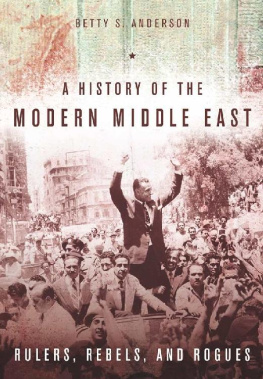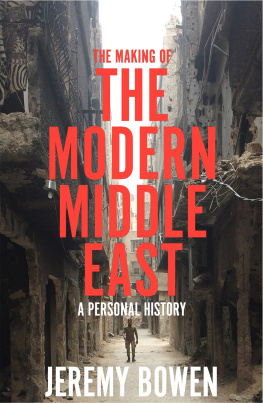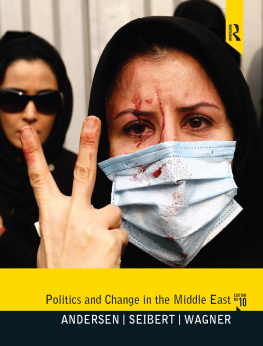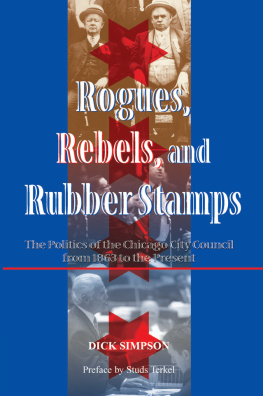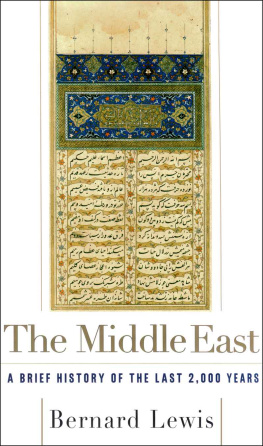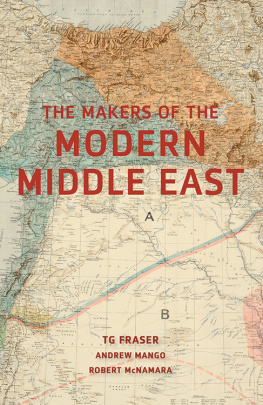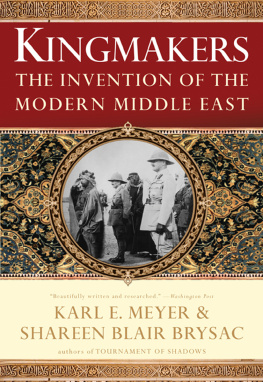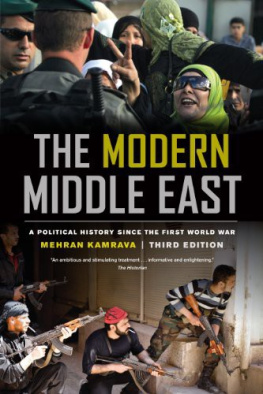Betty S. Anderson - A History of the Modern Middle East: Rulers, Rebels, and Rogues
Here you can read online Betty S. Anderson - A History of the Modern Middle East: Rulers, Rebels, and Rogues full text of the book (entire story) in english for free. Download pdf and epub, get meaning, cover and reviews about this ebook. year: 2016, publisher: Stanford University Press, genre: Science / Politics. Description of the work, (preface) as well as reviews are available. Best literature library LitArk.com created for fans of good reading and offers a wide selection of genres:
Romance novel
Science fiction
Adventure
Detective
Science
History
Home and family
Prose
Art
Politics
Computer
Non-fiction
Religion
Business
Children
Humor
Choose a favorite category and find really read worthwhile books. Enjoy immersion in the world of imagination, feel the emotions of the characters or learn something new for yourself, make an fascinating discovery.
- Book:A History of the Modern Middle East: Rulers, Rebels, and Rogues
- Author:
- Publisher:Stanford University Press
- Genre:
- Year:2016
- Rating:3 / 5
- Favourites:Add to favourites
- Your mark:
- 60
- 1
- 2
- 3
- 4
- 5
A History of the Modern Middle East: Rulers, Rebels, and Rogues: summary, description and annotation
We offer to read an annotation, description, summary or preface (depends on what the author of the book "A History of the Modern Middle East: Rulers, Rebels, and Rogues" wrote himself). If you haven't found the necessary information about the book — write in the comments, we will try to find it.
A History of the Modern Middle East: Rulers, Rebels, and Rogues — read online for free the complete book (whole text) full work
Below is the text of the book, divided by pages. System saving the place of the last page read, allows you to conveniently read the book "A History of the Modern Middle East: Rulers, Rebels, and Rogues" online for free, without having to search again every time where you left off. Put a bookmark, and you can go to the page where you finished reading at any time.
Font size:
Interval:
Bookmark:
Stanford University Press
Stanford, California
2016 by the Board of Trustees of the Leland Stanford Junior University.
All rights reserved.
No part of this book may be reproduced or transmitted in any form or by any means, electronic or mechanical, including photocopying and recording, or in any information storage or retrieval system without the prior written permission of Stanford University Press.
Printed in the United States of America on acid-free, archival-quality paper
Library of Congress Cataloging-in-Publication Data
Names: Anderson, Betty S. (Betty Signe), 1965 author.
Title: A history of the modern Middle East : rulers, rebels, and rogues / Betty S. Anderson.
Description: Stanford, California : Stanford University Press, 2016. | Includes bibliographical references and index.
Identifiers: LCCN 2015050232 | ISBN 9780804783248 (pbk. : alk. paper)
Subjects: LCSH: Middle EastHistory1517Textbooks. | Middle EastPolitics and governmentTextbooks.
Classification: LCC DS62.4.A63 2016 | DDC 956dc23
LC record available at http://lccn.loc.gov/2015050232
ISBN 9780804798754 (electronic)
Designed by Bruce Lundquist
Typeset at Stanford University Press in 10/15 Sabon LT
A History of the Modern Middle East
RULERS, REBELS, AND ROGUES
Betty S. Anderson
Stanford University Press
Stanford, California
Contents
Boxes
Illustrations
Maps
Preface
This book begins with Turkic migrants moving from Central Asia to the Middle East because they were pivotal for the founding of the Ottoman (14th century) Empire and instrumental to the establishment of the Safavid (16th century) Empire. From there, the book proceeds to the current day. I chose to start with the founding stories of these empires because the governmental structures their leaders established and the relationships forged between state and subjects provide valuable background information for the changes wrought in the more traditionally defined modern era of the late 18th century forward. The Ottoman Empire influenced societal and governmental relationships throughout most of the Middle East for centuries and even for years after its dismantlement in 1923; Safavid strengths and weaknesses both became issues to be tackled by the Qajar (1796) and Pahlavi (1925) successors and integral parts of Iranian national and governmental identity. The text focuses on Egypt, Israel-Palestine, Jordan, Saudi Arabia, Lebanon, Syria, Iraq, Turkey, and Iran within the region while recognizing the changing roles that Britain, France, Russia/the Soviet Union, and the United States have played in these countries for centuries.
In examining these empires, their many state successors, and their foreign influences, I address the term Rulers that appears in the books subtitle. To determine how rulers over many centuries and within different kinds of state structures came to power and maintained it, I analyze the bases for the rulers authority, the institutions that implemented the leaders policies, and the groups and people who became stakeholders in the state systems because they worked for the state and believed in the legitimacy of the leadership. I foreground state governance as the core thread connecting the narrative across centuries and borders, while illustrating the integrated nature of the relationships that has existed between the governors and the governed since the founding of these empires many centuries ago.
The recent upheavals throughout the Middle East provide the other side of the historical bookend for this text and open a window onto who the Rebels and Rogues of the subtitle are. On February 14, 2005, former Lebanese prime minister Rafiq Hariri died in an enormous explosion. Over the next months, Lebanese citizens massed in demonstrations against the Syrian government for its alleged complicity in the attack and for remaining in occupation of portions of Lebanon since 1976. Even with followers of Hizballah supporting a continuing Syrian presence in Lebanon, Syria withdrew from the country by the end of April 2005. In June 2009, millions of Iranians took to the streets to protest the reelection of President Mahmoud Ahmadinejad and the fraud that accompanied it. Before the election, dramatic actions such as a human chain of 150,000 people circled Tehran in support of candidate Mir-Hossein Mousavi. After the government issued the election results, protesters began with silent demonstrations for four days, as people stood together but did not yell out any slogans. Within days Ahmadinejad and his police and security agencies successfully repressed the movement, and Ahmadinejad began his second term; as many as 150 people died in the clashes with police. This movement came to be called the Green Revolution because of the prevalence of green banners among the protesters in support of Mousavis campaign and the democratic slogans ringing out.
The events of the Arab Spring were sparked on December 17, 2010, when Tunisian Mohamed Bouazizi immolated himself and died the following day from his injuries. His act was a protest against the dire economic conditions he faced in Tunisia and the stark gap between rich and poor arising around him. His death triggered massive, countrywide demonstrations against the government of Zine El Abidine Ben Ali, who had been in power since 1987 and was now forced to flee to Saudi Arabia on January 14, 2011. Similar demonstrations erupted in Tahrir Square in Cairo on January 25, 2011, and when these demonstrations also became countrywide over the next 18 days, President Husni Mubarak resigned on February 11, 2011, and turned executive authority over to the Supreme Muslim Council of the Armed Forces (SCAF), led by Defense Minister Field Marshal Hussein Tantawi.
On February 27, 2012, President Ali Abdullah Saleh of Yemen stepped down after 12 years as president of a united Yemen and 22 years earlier as president of North Yemen. Like dominoes, surrounding states faced similar upheavals, with a Syrian uprising beginning in the southern town of Dara in March 2011. Muammar Qaddafis 42-year tenure as leader of Libya ended under bombardment from NATO; he died at the hands of rebels on October 20, 2011. The governments of Jordan, Saudi Arabia, and Bahrain faced repeated demonstrations that these leaders were able to quell but not eliminate completely. On May 28, 2013, protesters came out into Gezi Park in Istanbul, a former Armenian cemetery and one of the last green spaces in the city, to oppose the governments urban development plans. The next year saw the demonstrations spread across the country and expand to include broader denunciations of corruption in the office of Turkish prime minister Recep Tayyip Erdoan.
The shifts in power and the attempts at transforming governmental leadership all came at the hands of diverse and often massive demonstrations against state leaders and their policies. The participants did not join because of one particular grievance or as members of one particular interest group. They protested against the lack of job opportunities for secondary and university graduates, rising levels of economic inequality, the poor quality of services provided by their governments, state brutality by police and security services, discriminatory water policies, and foreign support for the dictators that led their state governments. They did so with overlapping identities, as youth, nationalists, Islamists, secularists, women, government employees, and workers.
Some wanted more state control over the economy; others wanted more privatization. Some wanted reform; others sought the complete overthrow of their governing structures. In Bahrain Shia wanted participatory rights in the government. In Egypt, the protesters deemed President Mubarak an unfit ruler over their government but recognized the legitimacy of the military to hold power in his stead; in Tunisia, a transformation of government has been undertaken that could dramatically change the relationship between state and citizenry. All the protesters could stand beside each other in the streets, regardless of their differing demands, because they agreed that collectively they had the right to demand change and that their governments could not be trusted to take the lead.
Next pageFont size:
Interval:
Bookmark:
Similar books «A History of the Modern Middle East: Rulers, Rebels, and Rogues»
Look at similar books to A History of the Modern Middle East: Rulers, Rebels, and Rogues. We have selected literature similar in name and meaning in the hope of providing readers with more options to find new, interesting, not yet read works.
Discussion, reviews of the book A History of the Modern Middle East: Rulers, Rebels, and Rogues and just readers' own opinions. Leave your comments, write what you think about the work, its meaning or the main characters. Specify what exactly you liked and what you didn't like, and why you think so.

